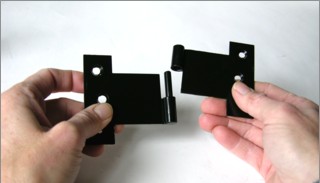Posts Tagged ‘Hinge Offset’

Finding the correct offset for exterior shutter hardware certainly can be daunting. But, with a little practice you’ll be well on your way to hanging your shutters with an offset that’s just right!
What is Hinge Offset and why is it needed?
Hinge Offset is the counterbalance needed for a shutter or door to easily swing open and close, clearing any obstacles such as a deep fitted window frame or trim mouldings. With a larger hinge offset a larger swing (also referred to as “throw”) is created making the shutter protrude, or kick out, further away from the pivot point of the hinge. Knowing which hinge offset you will need is just a matter of finding the amount of throw needed.
Hardware Basics
Hinges are comprised of two parts. 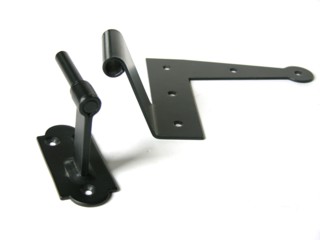
Exterior strap hinges and the “L” type straps (also called “New York style hinges”) shown here on the right consist of a strap and a pintle. In this picture the pintle is on the left and the strap is on the right. The strap mounts to the shutter’s back face and the pintle mounts to the building. Most, if not all shutter and door hinges, are made to be able to separated for installation, as well as general maintenance, hence the term “Lift off Hinge or Loose Pin Hinge”.
Measuring Offsets for Plate Mount Strap Type Hinges
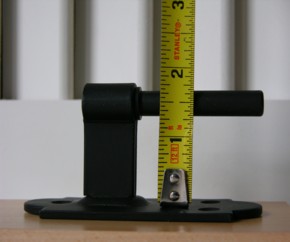
Pintle offset is measured from the base, to the center of the pintle, or pin. When measuring pintle offset sometimes the plate will be included and sometimes not. The measurement will be close enough to measure either way. In this picture I did not incude measuring the plate portion of the pintle that the tape measure is seated on. See how the measurement is one and a half inches ( 1-1/2″ ) to the center of this pintle pin shown to the right?
Measuring the offset on the strap is similar to measuring the pintle offset. Just measure to the center of the knuckle, the hinge joint, less the strap thickness like I did in this picture below.
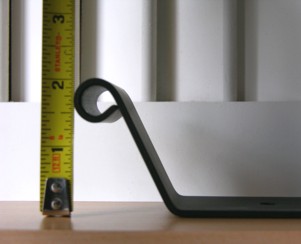
Just remember that you must measure the strap perpendicular to the portion that is mounted on the shutter face and not the angle as I am in the picture above.
Typically the strap offset is matched with the pintle offset. From closest to furthest in the picture shown below are half inch (1/2″), one and a half (1-1/2″) and three and a quarter (3-1/4″) offsets.
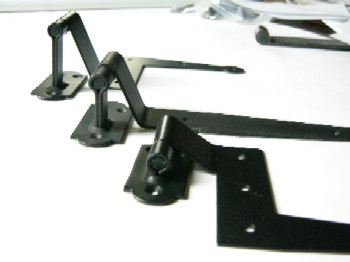
Offsets for Edge Mortise Types
Edge Mortise hinges shown in the picture to the right are also known as butt hinges. Butt hinges consist of two sections or leaves. The pivot pin is located on one of the leaf knuckles. They can be an “H” style (also called a Parliament hinge) as shown or a plain squared version that is our HE1-401 style. Click the picture below for both examples.
For another example of an edge mortise hinge just take a look at your home’s entrance door. See how the hinge leaves are flush with the surface? This is known as hinges that are mortised in. One side of the hinge is mortised flush on the edge of the door and the other half with the pin is mortised flush into the door frame also known as a jamb. It is the same idea for a shutter.
Offsets are measured on an edge mortised butt hinge by taking the distance from the outer edge of the hinge leaf to the center of the pin. You can also just divide the full width of the hinge, both leaves open on a flat surface, and divide by two.
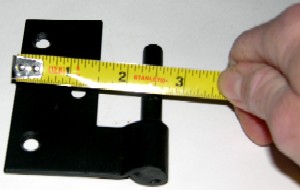
This hinge shown is referenced as a jamb leaf pintle. It’s the same idea for mounting as an edge mortise hinge, mounts to the jamb. The leaf shown has an offset of 2-1/2″ from the outer edge. Sometimes you’ll see offset measured from the inside leaf to the center of the pin. In this picture you can see that would be about 1″ from the inside leaf edge to the center of the pin. If you are going to use this type hinge or even the edge mortise types you need to make sure that the jamb is wide enough for the leaf plate to be securely screwed down.
Whether it is a strap hinge or a butt hinge the pin portion is mounted to the frame. In some cases this will be reversed for strap shutter or gate hardware if the pin is made to be on the straps knuckle. This feature is true of many hinges found on Old Philadelphia Federal Shutters. Regardless of where the pin is located the offset rules will still apply.
How to find your offset

Minimum hinge throw required
The distance from where the hinge will mount to the house to front face of the trim or casing that protrudes out the furthest from your home’s façade is the minimum throw required. This is shown in figure 2 below. If there is no trim or casing, as in many brick and stone homes as shown here to the right and at the beginning of this article, then the minimum hinge throw required will be the distance from where the pintle mounts on the frame to the façade.
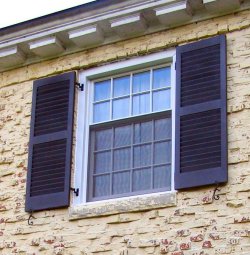
Using what you now know about hinge offsets take a look at this picture-
Do you see the pintle’s large offset, the projection out from the window frame? Along with the matched offset on the “L” strap hinge the shutter now has adequate “throw” kicking it far enough away from the exterior wall. This is the key to knowing which offset to use- just find your throw.

Fig. 1
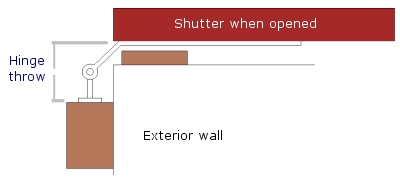
Fig. 2
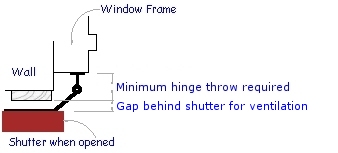
Fig. 3
A ½” – 1-1/2” ventilation space is recommended between façade and shutter.
Along with the minimum throw you’ll need to add enough offset to include an area for a ventilation space, a gap, behind the shutters when they are open and tied back against the wall with shutter dogs. This will help the wood ventilate so they do not retain moisture. It will also help ventilate the house wall too. There is no rule for how much ventilation space is required but it typically ranges from about a half to one and a half inches when the shutters are held open with tiebacks.
The following charts show some common offsets that we offer and their throw.
Table A – Use this chart for when the pintle offset equals the strap offset:
| Hinge Offset | Hinge Throw | Minimum Hinge Throw Required |
| 1/2″ | 1″ | 0″ to 1/2″ |
| 1.1/2″ | 3″ | 0″ to 2.1/2″ |
| 2.1/4″ | 4.1/2″ | 0″ to 4″ |
| 3.1/4″ | 6.1/2″ | 0″ to 6″ |
Table B
Some of the hinges that we sell can have split offsets. You might need a large pintle projection from the house and a smaller offset on the shutter hinge. Use this chart for when the pintle offset does not equal the strap offset
| Pintle Offset | Strap Offset | Hinge Throw | Minimum Hinge Throw Required |
| 1″ | 0″ | 1″ | 0″ to 1/2″ |
| 1″ | 1″ | 2″ | 0″ to 1.1/2″ |
| 1″ | 2″ | 3″ | 0″ to 2.1/2″ |
| 2″ | 0″ | 2″ | 0″ to 1.1/2″ |
| 2″ | 1″ | 3″ | 0″ to 1.1/2″ |
| 2″ | 2″ | 4″ | 0″ to 2.1/2″ |
Every window can be different…
Are you still not sure which shutter hinge to use?
Below are a some helpful paper cut out worksheets that you can print out. These templates can be helpful to place where your new shutter hardware will be installed to make sure that you will have adequate offset.
Your printer defaults should be fine for these worksheets to print to scale but if the measurements are incorrect just make sure that your printer is set to a a one to one (1:1) ratio in order for the cut-out templates to work.
![]()
Click & Print:

A naturally beautiful and renewable choice – Wood shutters and doors by
